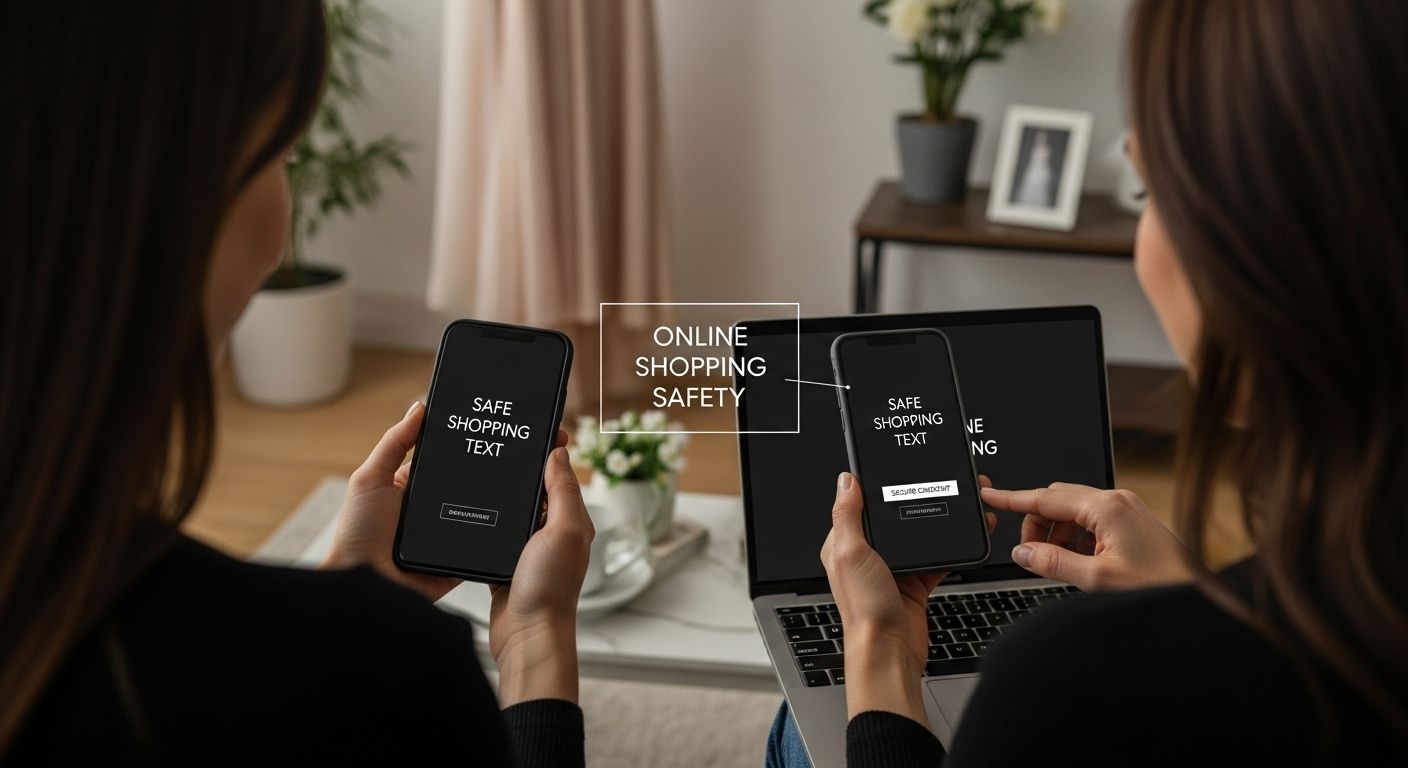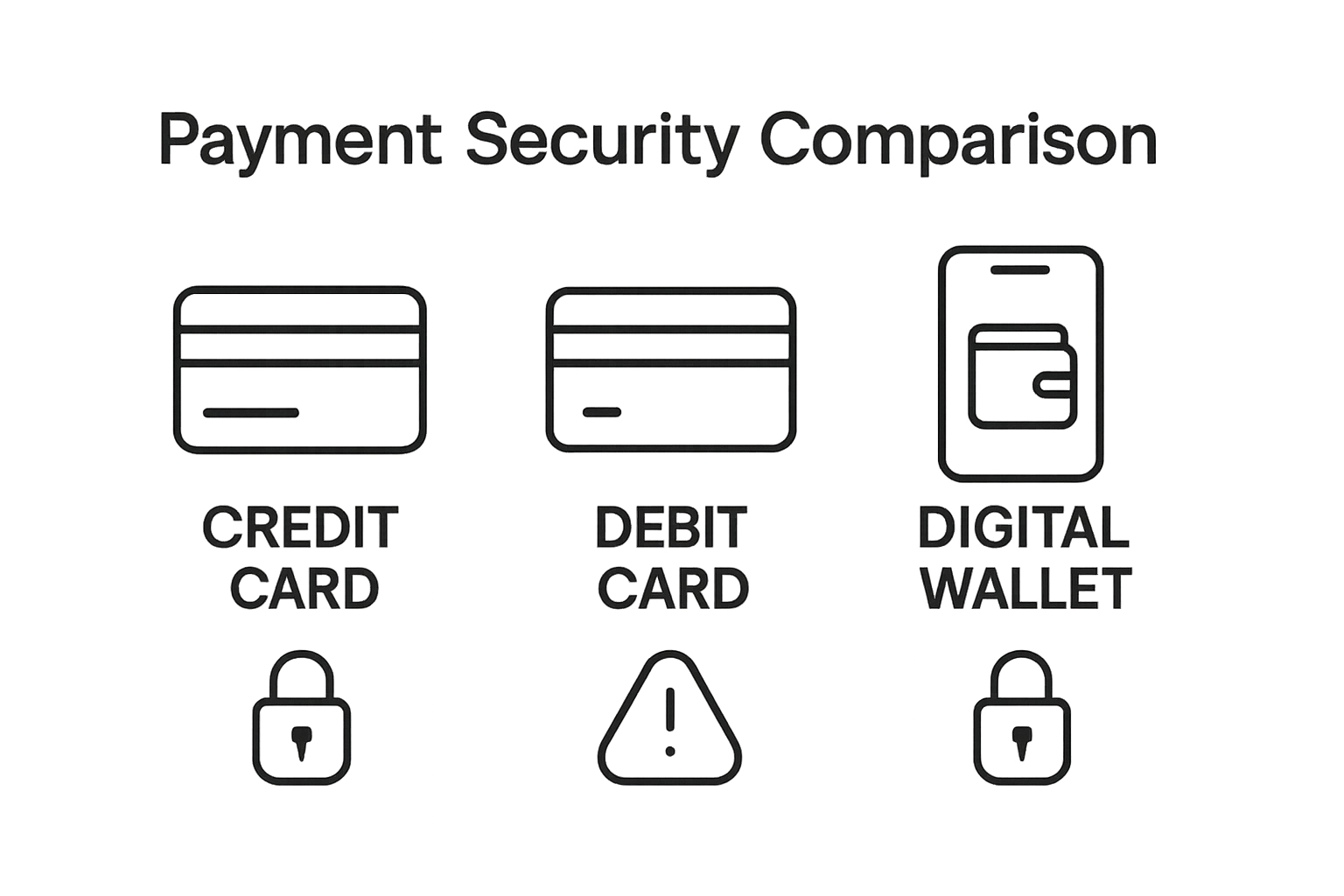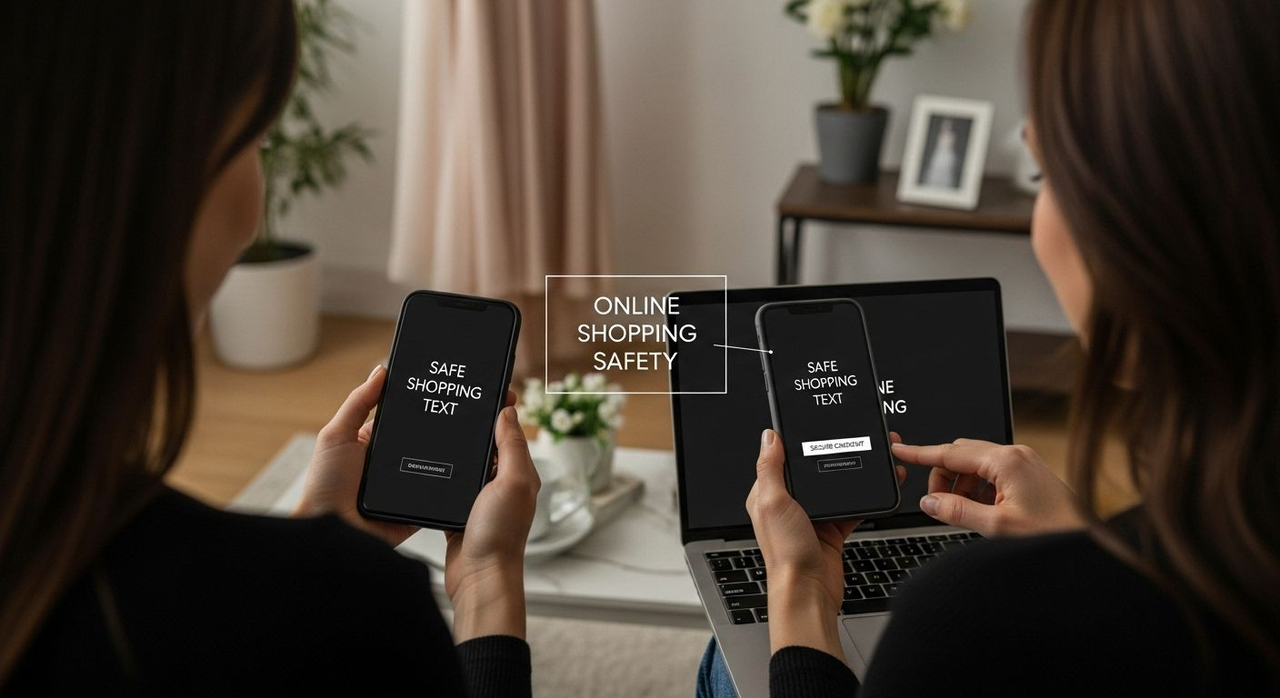Understanding Online Shopping Safety Tips for Special Events
Understanding Online Shopping Safety Tips for Special Events

Online shopping has made buying that perfect dress just a click away. Cyber risks keep growing with over $16 billion in internet crime losses reported in 2024. Most people think it’s all about avoiding sketchy websites, but the real threat often comes from payment methods you trust the most.
Table of Contents
- What Are Online Shopping Safety Tips And Why They Matter
- How Online Shopping Works And Its Risks
- Understanding Secure Payment Methods And Their Importance
- Recognizing Fake Websites And Red Flags To Watch For
- The Role Of Reviews And Feedback In Safe Shopping Decisions
Quick Summary
| Takeaway | Explanation |
|---|---|
| Verify website security before shopping | Always check for HTTPS and valid security certificates to protect your information. |
| Use credit cards for secure transactions | Credit cards offer robust fraud protection and liability coverage against unauthorized charges. |
| Recognize red flags on shopping websites | Look for poor design, unusual payment requests, and lack of contact information to identify scams. |
| Analyze customer reviews critically | Evaluate reviews for authenticity and balance, identifying potential manipulation or bias in feedback. |
| Stay vigilant against phishing attempts | Be cautious of emails and websites that ask for personal information or payment details without proper verification. |
What are Online Shopping Safety Tips and Why They Matter
Online shopping has transformed how people purchase special occasion dresses, making it convenient and accessible. However, this digital convenience comes with potential risks that require careful navigation. Understanding online shopping safety tips is crucial for protecting personal information, financial details, and ensuring a secure purchasing experience.
The Digital Landscape of Online Shopping Risks
In our increasingly connected world, cybercriminals continuously develop sophisticated methods to exploit online shoppers. According to the FBI Internet Crime Complaint Center, over 859,532 internet crime complaints were filed in 2024, resulting in more than $16 billion in reported losses. These staggering numbers underscore the critical importance of implementing robust online shopping safety strategies.
Key risks in the digital shopping environment include:
- Phishing websites designed to steal personal information
- Fraudulent sellers offering fake or non-existent products
- Unsecured payment gateways vulnerable to data theft
- Identity theft through compromised online accounts
- Unauthorized credit card charges
Understanding the Core Principles of Online Shopping Safety
Effective online shopping safety is not about paranoia but about informed and strategic decision-making. It involves developing a comprehensive approach that protects your personal and financial information across all digital shopping platforms. This means being proactive, vigilant, and equipped with knowledge about potential threats.
Critical safety principles include verifying website security, using strong passwords, monitoring financial statements, and understanding the signs of potential online shopping scams. By adopting these practices, shoppers can significantly reduce their vulnerability to digital threats while enjoying the convenience of online retail.
The goal is not to discourage online shopping but to empower consumers with the tools and knowledge necessary to shop confidently and securely. Each purchase made with awareness contributes to a safer, more trustworthy digital marketplace.
How Online Shopping Works and Its Risks
Online shopping represents a complex digital ecosystem where consumers interact with virtual storefronts, exchanging money for goods without traditional face-to-face transactions. This technological process involves multiple interconnected systems that enable seamless purchasing experiences while simultaneously presenting unique vulnerabilities.
The Digital Transaction Mechanism
At its core, online shopping functions through sophisticated web platforms that replicate traditional retail interactions. When a customer selects an item, sophisticated backend systems validate product availability, process payment information, and coordinate shipping logistics. According to CISA’s cybersecurity guidelines, this digital transaction involves several critical stages:
- Authentication of user credentials
- Secure payment gateway processing
- Real-time inventory verification
- Encryption of sensitive financial data
- Order routing to fulfillment centers
Technical and Financial Vulnerabilities
Each stage of online shopping introduces potential risks that sophisticated cybercriminals can exploit. Digital transactions create multiple potential breach points where personal and financial information might be compromised. These vulnerabilities emerge from:
- Weak website security protocols
- Unencrypted payment channels
- Potential server-side data storage risks
- Complex supply chain information networks
- Third-party payment processor interactions
The intricate nature of online shopping means that consumers must remain vigilant. Understanding how digital transactions work provides the foundation for recognizing potential security threats. By comprehending the underlying mechanics of online purchasing, shoppers can make more informed decisions and implement proactive protective strategies.
Modern online shopping platforms invest heavily in advanced security technologies like machine learning algorithms, real-time fraud detection systems, and multi-factor authentication to mitigate these risks. However, consumer awareness and personal vigilance remain the most critical components in maintaining digital transaction safety.
Understanding Secure Payment Methods and Their Importance
Payment methods are the critical financial bridges connecting consumers with online retailers, representing far more than simple transaction tools. These digital pathways carry significant implications for personal financial security, requiring sophisticated understanding and strategic selection.
The Hierarchy of Payment Security
Not all payment methods offer equal levels of protection. Credit cards consistently emerge as the most secure online payment option, providing robust consumer safeguards against fraudulent transactions. According to Consumer Financial Protection Bureau guidelines, credit card transactions offer multiple layers of protection:
- Zero liability for unauthorized charges if reported promptly
- Comprehensive fraud protection mechanisms
- Automatic chargeback rights for undelivered merchandise
- Enhanced transaction tracking and dispute resolution
- Built-in purchase insurance for many transactions
Comparative Risk Assessment of Payment Platforms
Different payment platforms present varying levels of inherent risk. Digital wallets, cryptocurrency, and direct bank transfers each carry unique security profiles that consumers must carefully evaluate. Debit cards represent the highest potential financial vulnerability, as they provide direct access to personal bank accounts with potentially limited recovery options.
Key considerations when selecting a payment method include:
- Transaction traceability
- Fraud recovery potential
- Level of personal information exposure
- Speed of potential fund restoration
- International transaction capabilities
The strategic selection of payment methods transcends mere convenience. It represents a critical personal financial management decision that directly impacts potential vulnerability to digital fraud. Consumers must approach online payment choices with the same thoughtfulness one might apply to selecting a personal financial advisor or protecting a critical investment.
To help you quickly compare the safety features and risks associated with different online payment methods discussed above, see the table below.
| Payment Method | Security Features | Risks/Weaknesses |
|---|---|---|
| Credit Card | Fraud protection, zero liability, chargebacks | Potential for card number theft if site is breached |
| Debit Card | Less robust fraud recovery, linked to bank account | Direct bank access, limited liability protection |
| Digital Wallet | Tokenization, limited info shared with merchants | Dependent on digital wallet security practices |
| Cryptocurrency | Anonymity, irreversible transactions | No chargebacks, hard to recover lost funds |
| Direct Bank Transfer | Direct transfer, bypasses card networks | Difficult to dispute or recover funds |

Recognizing Fake Websites and Red Flags to Watch For
The digital marketplace presents a complex landscape where sophisticated cybercriminals create increasingly convincing online storefronts designed to deceive unsuspecting consumers. Understanding the nuanced characteristics of fake websites requires a comprehensive approach to digital literacy and critical online evaluation.
Visual and Structural Website Authenticity Indicators
Website legitimacy goes far beyond surface-level appearance. Subtle design elements and structural inconsistencies often reveal potential fraudulent platforms. According to CISA’s online shopping safety guidelines, consumers should scrutinize multiple aspects of a website’s presentation:
- Poorly designed graphics or inconsistent branding
- Lack of clear contact information
- Absence of comprehensive product descriptions
- Unprofessional or generic website layout
- Suspicious domain names with unusual spellings
Advanced Red Flags in Digital Retail Environments
Cybercriminals employ sophisticated techniques to mimic legitimate online stores, making detection increasingly challenging. Warning signs extend beyond visual cues and into transactional and communication patterns. Critical red flags include:
- Requests for payment through unconventional methods
- Prices significantly lower than market rates
- Limited or non-existent customer reviews
- Aggressive marketing tactics with urgent purchase messaging
- Lack of secure payment gateway certifications
The digital landscape demands continuous vigilance. Consumers must develop a critical eye, treating each online interaction as a potential security challenge. Verifying website authenticity is not about distrust but about protecting personal and financial information in an increasingly complex digital ecosystem.
The following table summarizes common online shopping risks and the specific warning signs shoppers should watch for, making it easier to recognize and avoid potential threats.
| Online Shopping Risk | Common Red Flags |
|---|---|
| Fake Websites | Poor graphics, suspicious domain, lack of contact info |
| Fraudulent Sellers | Prices too good to be true, no customer reviews |
| Unsecured Payment Gateways | Absent HTTPS, missing security certificates |
| Phishing Attempts | Emails/links asking for info, urgency in communications |
| Identity Theft | Request for unusual personal/financial details |

The Role of Reviews and Feedback in Safe Shopping Decisions
Customer reviews represent more than simple product commentary; they function as critical consumer intelligence networks that provide unprecedented insights into product quality, seller reliability, and potential purchasing risks. These digital testimonials have transformed how shoppers make informed decisions in an increasingly complex online marketplace.
The Psychological Mechanics of Review Evaluation
Consumer reviews serve as crowdsourced risk assessment tools, offering potential buyers transparent perspectives beyond marketing narratives. According to Federal Trade Commission guidelines, understanding review dynamics involves recognizing multiple layers of potential manipulation and authenticity:
- Verified purchase indicators
- Detailed, specific product descriptions
- Balance between positive and critical feedback
- Consistency in reviewer communication styles
- Patterns of review volume and timing
Strategies for Effective Review Analysis
Navigating the complex landscape of online reviews requires developing sophisticated evaluation skills. Sophisticated consumers look beyond star ratings to understand the nuanced context of each review. Critical analysis involves examining review patterns, assessing credibility, and understanding potential biases.
Key considerations when evaluating reviews include:
- Cross-referencing feedback across multiple platforms
- Identifying potentially fabricated or incentivized reviews
- Examining reviewer profiles and history
- Understanding the difference between subjective experiences and objective product assessments
- Recognizing potential seller-generated or competitor-generated content
Review analysis is not about finding perfect consensus but understanding the broader narrative of product performance and seller reliability. By approaching reviews as complex communication systems, consumers can transform seemingly chaotic feedback into structured, actionable intelligence for safer online shopping experiences.
Shop with Confidence for Your Next Special Occasion
Worried about the risks of online shopping when finding the perfect dress for your event? If you’re concerned about websites that are not trustworthy, unsafe payment methods, or falling victim to scams, you are not alone. The article above unpacks the realities of digital shopping risks like phishing, fake sellers, and compromised payment gateways, especially when you are searching for special occasion attire. At Dress Me Up NY, we help you shop securely so you can focus on expressing your unique style, not worrying about your safety.

Why wait and risk missing out on the latest trends or trusted deals? Shop our visually rich catalog of evening gowns, prom dresses, and wedding guest looks, all backed by advanced website security, flat-rate shipping offers, and a commitment to protecting your personal information. Take the first step in safe and fashionable shopping by visiting Dress Me Up NY and experience a seamless, secure journey from browsing to checkout. Your next event deserves style and peace of mind—explore our collections now.
Frequently Asked Questions
What are some key online shopping safety tips for special events?
To shop safely online for special events, verify website security by checking for HTTPS, use strong, unique passwords, enable two-factor authentication, and monitor your financial statements for any unauthorized charges.
How can I recognize fake websites when shopping online?
To identify fake websites, look for indicators such as poor design, lack of contact information, suspicious domain names, and requests for uncommon payment methods. Always scrutinize the website’s structure and branding for inconsistencies.
What payment methods are considered the safest for online purchases?
Credit cards are generally the safest payment method for online purchases due to their consumer protection features, such as zero liability for fraudulent charges and chargeback options. Digital wallets also offer a good level of security but assess the risks of each method carefully.
How can I interpret customer reviews to ensure safe online shopping?
When evaluating customer reviews, look for verified purchase indicators, balance between positive and negative feedback, and specific product details. Cross-reference reviews across multiple platforms to gauge credibility and identify potential biases.
Recommended
- Tarik Ediz 54199 Taffeta Plunging Neck Sleeveless Long Dress
- Terani Couture 1811GL6436 Deep V-neck Long-sleeve Dress
- Clarisse 810413 Plunging V-neck Sequin Stretchy Prom Dress
- Terani Couture 251P4500 Tulle Off-Shoulder Straps Ballgown

